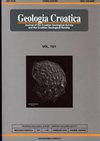上白垩统(上坎帕尼亚-马斯垂克)浮游有孔虫生物地层、岩性与Palmyrides(叙利亚)古近系演替
IF 1.1
4区 地球科学
Q3 GEOLOGY
引用次数: 1
摘要
在叙利亚Palmyrdes地区的六口深探井中,对上坎潘阶至上渐新世的地层序列进行了检查。大多数沉积序列包含丰富且保存良好至中等程度的浮游有孔虫组合,这些组合能够成功确定年龄。上坎潘阶和马斯特里赫特阶浮游动物群高度多样化,以暖水类群为主,如埃及球藻、甘瑟菌、哈氏球藻、角氏球藻和秀丽隐丝假构藻。最引人注目的更替发生在白垩纪/古新世边界,当时大多数浮游有孔虫物种灭绝。最古老的古新世浮游有孔虫组合,标本数量丰富,但种类不多,包括以下物种:始球虫、球虫、古孔虫、Chiloguembelina morsi、Woodringina claytonensis和拟大泡虫。古新世晚期的特征是双壳虫类、粉螨类和球头虫类的起源,而始新世早期的特征是热带群落,以褐藻类为主,最近部分的Acarinina和Subbotina物种形成强烈。这些物种大多延续到始新世中期,成为浮游生物群落的重要组成部分。始新世中期的特征是温水属的密集物种形成和统治,如Acarinina属、Morozovelloides属,以及较小程度的Turborotalia属、Globigerinatheka属和Hantkenina属。始新世中晚期边界的标志是最后一个褐藻类群Acarinina mcgowrani和Morozovelloides crassatus的双重灭绝,这表明气候多变、水柱不稳定和地表栖息地的丧失。相比之下,在始新世晚期,Turborotalia和Globigerinateheka变得更加重要。始新世/渐新世边界以大多数暖水类群的灭绝为标志,包括斑尾轮藻群、汉特肯属、Globigerinatheka和一些亚类。渐新世早期的开始是由冷水分类群的统治所指示的,如齿珠藻属、Globrotaloides、Tenuitella和Chiloguembelina。刺状表面居民Ciperoella ciperoensis群的形态反映了渐新世晚期的变暖。岩性与浮游有孔虫组合的多样性和组成的综合观测表明,叙利亚的Palmpydes地区是一个特提斯生物区,从坎帕尼亚晚期到始新世末,属于热带到亚热带气候,沉积在深海环境中(上半深海到外陆架)。相反,渐新世沉积物及其微体化石含量表明,气候条件温和至温暖,沉积在中陆架至内陆架环境中。本文章由计算机程序翻译,如有差异,请以英文原文为准。
Planktonic foraminiferal biostratigraphy and lithology of the Upper Cretaceous (upper Campanian-Maastrichtian) and Palaeogene succession of the Palmyrides (Syria)
An upper Campanian to upper Oligocene stratigraphic succession has been examined from six deep exploration wells in the Palmyrides area of Syria. Most of the sedimentary succession contains rich and well to moderately preserved planktonic foraminiferal assemblages that enable successful age determination. The upper Campanian and Maastrichtian planktonic fauna is highly diverse with domination of warm water taxa such as Globotruncana aegyptiaca, Gansserina gansseri, Globotruncanella havanensis, Globotruncanita angulata and Pseudotextularia elegans. The most dramatic turnover occurred across the Cretaceous/Palaeocene boundary when most planktonic foraminiferal species became extinct. The oldest Palaeocene planktonic foraminiferal assemblage, rich in the number of specimens, but not very diverse, includes the following species: Eoglobigerina eobulloides, Globanomalina archeocompressa, Chiloguembelina morsei, Woodringina claytonensis and Parasubbotina pseudobulloides. The late Palaeocene is marked by origination of the morozovellids, acarininids and globanomalinids, while the early Eocene is characterized by a tropical assemblage, dominated by muricate species, and by intensive speciation of Acarinina and Subbotina in the latest part. Most of these species continue into the middle Eocene and become a significant component of the planktonic community. The middle Eocene is characterized by intensive speciation and domination of warm water genera such as Acarinina, Morozovelloides, and to a lesser degree Turborotalia, Globigerinatheka and Hantkenina. The middle/late Eocene boundary is marked by double extinction of the last muricate taxa Acarinina mcgowrani and Morozovelloides crasssatus, which indicate a variable climate, water column instability, and loss of surface habitats. In contrast, Turborotalia and Globigerinateheka become more important in the late Eocene. The Eocene/Oligocene boundary is marked by the extinction of most warm water taxa including Turborotalia cerroazulensis group, Hantkenina, Globigerinatheka and some subbotinids. The beginning of the early Oligocene is indicated by the domination of cool water taxa such as Dentoglobigerina, Globorotaloides, Tenuitella and Chiloguembelina. Speciation of the spinose surface dweller Ciperoella ciperoensis group reflects warming in the late Oligocene. The combined observations of lithology with the diversity and composition of planktonic foraminifera assemblages indicate that the Palmyrides area in Syria was a Tethyan bioprovince with a tropical to subtropical climate from the late Campanian to the end of the Eocene with deposition in deep sea environments (upper bathyal to outer shelf). In contrast, Oligocene deposits and their microfossil content suggest temperate to warm climate conditions and sedimentation in middle to inner shelf environments.
求助全文
通过发布文献求助,成功后即可免费获取论文全文。
去求助
来源期刊

Geologia Croatica
GEOSCIENCES, MULTIDISCIPLINARY-
CiteScore
2.90
自引率
23.10%
发文量
35
审稿时长
>12 weeks
期刊介绍:
Geologia Croatica welcomes original scientific papers dealing with diverse aspects of geology and geological engineering, the history of the Earth, and the physical changes that the Earth has undergone or it is undergoing. The Journal covers a wide spectrum of geology disciplines (palaeontology, stratigraphy, mineralogy, sedimentology, petrology, geochemistry, structural geology, karstology, hydrogeology and engineering geology) including pedogenesis, petroleum geology and environmental geology.
Papers especially concerning the Pannonian Basin, Dinarides, the Adriatic/Mediterranean region, as well as notes and reviews interesting to a wider audience (e.g. review papers, book reviews, and notes) are welcome.
 求助内容:
求助内容: 应助结果提醒方式:
应助结果提醒方式:


